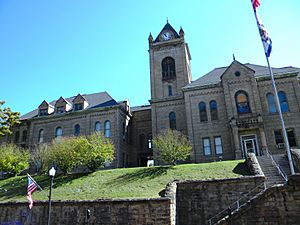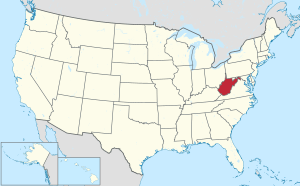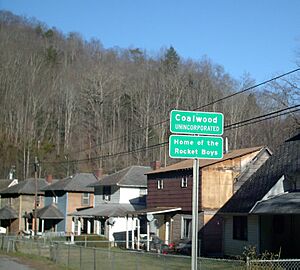McDowell County, West Virginia facts for kids
Quick facts for kids
McDowell County
|
|
|---|---|

McDowell County Courthouse in Welch
|
|
| Nickname(s):
Free State of McDowell
|
|

Location within the U.S. state of West Virginia
|
|
 West Virginia's location within the U.S. |
|
| Country | |
| State | |
| Founded | February 28, 1858 |
| Named for | James McDowell |
| Seat | Welch |
| Largest city | Welch |
| Area | |
| • Total | 535 sq mi (1,390 km2) |
| • Land | 533 sq mi (1,380 km2) |
| • Water | 1.4 sq mi (4 km2) 0.3%% |
| Population
(2020)
|
|
| • Total | 19,111 |
| • Estimate
(2023)
|
17,439 |
| • Density | 35.72/sq mi (13.792/km2) |
| Demonym(s) | McDowellian (Colloquial) |
| Time zone | UTC−5 (Eastern) |
| • Summer (DST) | UTC−4 (EDT) |
| Congressional district | 1st |
McDowell County is a county in the State of West Virginia. As of the 2020 census, the population was 19,111. Its county seat is Welch. McDowell County is the southernmost county in the state. It was created in 1858 by the Virginia General Assembly and named for Virginia Governor James McDowell. It became a part of West Virginia in 1863, when several Union-affiliated counties seceded from the state of Virginia during the American Civil War. McDowell County is located in the Cumberland Mountains, part of the Appalachia region.
Due mostly to a decline in employment in the coal mining industry, McDowell County's population has decreased from almost 100,000 in 1950 to less than 20,000 in 2020. .....
Contents
History
On February 20, 1858, McDowell County was formed from the northern portion of Tazewell County, Virginia. In 1861, as the nation lurched toward civil war, delegates from McDowell County voted in favor of Virginia's secession from the United States. The northwestern counties of the region were Union-affiliated and voted to secede from Virginia the following year, but McDowell, Greenbrier, Logan, Mercer, Monroe, Pocahontas, Webster, and Wyoming counties in the southern section all refused to participate. The status of these eight counties would be decided by the United States Supreme Court in the case of Virginia v. West Virginia.
McDowell was one of fifty former Virginia counties that were recognized as the state of West Virginia on June 20, 1863. The same year, the residents of McDowell County chose Perryville, now English, then the most populous town, as their new county seat. However, in 1866 the state legislature relocated the county seat to a farm near the mouth of Mill Creek. There it remained until 1874, when it returned to Perryville. The location of the county seat remained in dispute until 1892, when it moved to Welch.
In 1863, West Virginia's counties were divided into civil townships, with the intention of encouraging local government. This proved impractical in the largely rural state, where population density was low. In 1872 the townships were converted into magisterial districts. McDowell County was divided into three districts: Big Creek, Elkhorn, and Sandy River. In the 1890s, Browns Creek District was formed from a portion of Elkhorn, and North Fork District was created from parts of Browns Creek and Elkhorn. A sixth district, Adkin, was created from part of Elkhorn District in the early 1900s. These districts remained stable until the 1980s, when Adkin, Elkhorn, and North Fork were consolidated into the district of North Elkin.
Referring to the unconventional demographics and political state of McDowell County, a local newspaper editor described the county as "the Free State of McDowell", a description that has stuck in the popular imagination. The origin of this moniker is unknown. Tom Whittico, the founder and first editor of The McDowell Times–the first African-American paper in West Virginia–, said he used it because African Americans had greater electoral power, civil freedoms, and freedom from segregation in McDowell County than in other locations in the state.
McDowell County had the first World War One Memorial to honor black soldiers.
By the first half of the 20th century, McDowell County's economy was dominated by coal mining. In 1950, it was the "leading coal producing county" in the United States. Sixteen percent of the county's population in 1950 was employed in the coal mining sector. However, in the next few decades major breakthroughs in mechanization in the coal industry resulted in job declines. By 1960 the mining workforce had decreased from around 16,000 to around 7,000. Many people left because of the lack of jobs, but people with longstanding family ties were reluctant to do so.
While running for president, John F. Kennedy visited McDowell County and promised to send help if elected. His first executive order created the Food Stamps program and the first recipients of food stamps were in McDowell County.
Geography
McDowell County, the southernmost county in West Virginia, is located at 37°22′N 81°39′W / 37.37°N 81.65°W. It is bordered by Tazewell County, Virginia, to the south; Buchanan County, Virginia, to the west; Mingo County to the northwest; Wyoming County to the north; and Mercer County to the east. The county is located in the Cumberland Mountains, a sub-region of the Appalachian Mountains. The highest elevation in the county is approximately 1,036 m (3,399 ft) on the northwest slope of Flat Top Mountain.
According to the United States Census Bureau, the county has a total area of 535 square miles (1,390 km2), of which 533 square miles (1,380 km2) is land and 1.4 square miles (3.6 km2) (0.3%) is water. The county is roughly in the shape of a semi circle, with the border following the mountains around the county.
Demographics
The county hit its peak of population in 1950 with almost 99,000 people, but job losses in the next decades caused sharp declines in population.
| Historical population | |||
|---|---|---|---|
| Census | Pop. | %± | |
| 1860 | 1,535 | — | |
| 1870 | 1,952 | 27.2% | |
| 1880 | 3,074 | 57.5% | |
| 1890 | 7,300 | 137.5% | |
| 1900 | 18,747 | 156.8% | |
| 1910 | 47,856 | 155.3% | |
| 1920 | 68,571 | 43.3% | |
| 1930 | 90,479 | 31.9% | |
| 1940 | 94,354 | 4.3% | |
| 1950 | 98,887 | 4.8% | |
| 1960 | 71,359 | −27.8% | |
| 1970 | 50,666 | −29.0% | |
| 1980 | 49,899 | −1.5% | |
| 1990 | 35,233 | −29.4% | |
| 2000 | 27,329 | −22.4% | |
| 2010 | 22,113 | −19.1% | |
| 2020 | 19,111 | −13.6% | |
| 2023 (est.) | 17,439 | −21.1% | |
| U.S. Decennial Census 1790–1960 1900–1990 1990–2000 2010–2020 |
|||
2020 census
| Race | Number | Percentage |
|---|---|---|
| White (NH) | 15,871 | 83.0% |
| Black or African American (NH) | 2,139 | 11.2% |
| Native American or Alaska Native (NH) | 20 | 0.1% |
| Asian (NH) | 20 | 0.1% |
| Pacific Islander (NH) | 4 | 0.0% |
| Some Other Race (NH) | 45 | 0.2% |
| Mixed/Multi-Racial (NH) | 622 | 3.3% |
| Hispanic or Latino | 390 | 2.0% |
| Total | 19,111 | 100.0% |
As of the 2020 census, there were 19,111 people, 7,483 households, 4,627 families residing in the county. The population density was 35.8 inhabitants per square mile (13.8/km2). There were 9,344 housing units. The racial makeup of the city was 84.7% White, 11.3% African American, 0.1% Native American, 0.1% Asian, 0.0% Pacific Islander, 0.3% from some other races and 3.4% from two or more races. Hispanic or Latino of any race were 2.0% of the population.
2010 census
As of the 2010 census, there were 22,113 people, 9,176 households, and 6,196 families residing in the county. The population density was 41.5 inhabitants per square mile (16.0/km2). There were 11,322 housing units at an average density of 21.2 per square mile (8.2/km2). The racial makeup of the county was 89.1% White, 9.5% Black or African American, 0.2% American Indian, 0.1% Asian, 0.0% from other races, and 1.1% from two or more races. Those of Hispanic or Latino origin made up 0.4% of the population. The largest ancestry groups were: 13.7% Irish, 12.0% German, 11.5% English, 8.0% American, 2.8% Sub-Saharan African, 2.7% Italian, 2.0% Dutch, and 1.1% Scotch-Irish.
Of the 9,176 households, 28.7% had children under the age of 18 living with them, 48.1% were married couples living together, 13.9% had a female householder with no husband present, 32.5% were non-families, and 28.8% of all households were made up of individuals. The average household size was 2.36 and the average family size was 2.86. The median age was 43.8 years.
The median income for a household in the county was $22,154 and the median income for a family was $28,413. Males had a median income of $31,229 versus $26,776 for females. The per capita income for the county was $12,955. About 27.5% of families and 32.6% of the population were below the poverty line, including 44.3% of those under age 18 and 20.1% of those age 65 or over.
Life expectancy
Of 3,142 counties in the United States in 2013, McDowell County ranked last in the life expectancy of both male and female residents. Males in McDowell County lived an average of 63.5 years and females lived an average of 71.5 years, compared to the national average for life expectancy of 76.5 for males and 81.2 for females. Moreover, the average life expectancy in McDowell County declined by 3.2 years for males and 4.1 years for females between 1985 and 2013, compared to a national average for the same period of an increased life span of 5.5 years for men and 3.1 years for women. High rates of smoking and obesity and a low level of physical activity appear to be contributing factors to the declining life expectancy for both sexes.
In 2020, the Robert Wood Johnson Foundation ranked McDowell County as 55th of 55 counties in West Virginia in "health outcomes," as measured by length and quality of life.
Economy
The county has been classified as a "food desert" by the USDA. In 2017, there were only two full-sized grocery stores to serve the county's 535 square miles (1,390 square kilometers). The county's only Walmart Supercenter, the county's largest employer, closed in 2016.
Financial services remain scant in the area. In 1999, The First National Bank of Keystone, the only bank located in the coal town of Keystone and the town's major employer at the time, was closed by the FDIC due to fraud. Management had been falsifying the bank's financial statements by booking income from loans the bank did not own, giving the appearance that the bank was generating large profits when it was in fact insolvent. At the height of the scandal, executives buried large volumes of documents in a trench in an attempt to conceal the fraud from the bank's accounting firm and from the Office of the Comptroller of the Currency.
Poverty
In 2022, McDowell was the 16th-poorest county in the U.S. (out of 3,143 counties), with a median annual household income of $28,235. The percentage of the population living in poverty was estimated at 37.6 percent. This compares with a median annual household income of $67,521 and a poverty rate of 11.4 percent in the U.S. as a whole.
Education
McDowell County Schools operates the county's public K-12 education system of 7 elementary schools, 2 middle schools, and 2 public high schools in McDowell County, which are Mount View High School and River View High School. The county also has a private school, Twinbranch Pentecostal Christian Academy which is located in Twinbranch.
McDowell County Schools were under state control as a 'take-over' county from 2001 to 2013. Some medical services have been brought onsite into schools to reduce student absenteeism among families with only one car, and personal items such as sneakers and backpacks are now made available to students. A mixed use, multistory building in Welch aimed at reducing the housing shortage for teachers opened in 2022.
Transportation
Major highways
 U.S. Route 52
U.S. Route 52 West Virginia Route 16
West Virginia Route 16 West Virginia Route 80
West Virginia Route 80 West Virginia Route 83
West Virginia Route 83 West Virginia Route 103
West Virginia Route 103 West Virginia Route 161
West Virginia Route 161 West Virginia Route 635
West Virginia Route 635
The West Virginia Division of Highways is currently trying to construct new highways, such as U.S. Route 121, known as the Coalfields Expressway.
Airport
The county had one airport, Welch Municipal Airport, which has closed indefinitely.
Communities
Cities
Towns
Magisterial districts
- Big Creek
- Browns Creek
- North Elkin
- Sandy River
Census-designated places
Unincorporated communities
- Algoma
- Apple Grove
- Asco
- Ashland
- Atwell
- Avondale
- Beartown
- Big Four
- Bishop (partial)
- Black Wolf
- Bottom Creek
- Canebrake
- Capels
- Caretta
- Carlos
- Carswell
- Coalwood
- Eckman
- Elbert
- Elkhorn
- English
- Ennis
- Erin
- Faraday
- Filbert
- Gilliam
- Havaco
- Hemphill
- Hensley
- Hull
- Isaban (part)
- Jacobs Fork
- Jed
- Jenkinjones
- Johnnycake
- Jolo
- Kyle
- Landgraff
- Leckie
- Lex
- Lila
- Litwar
- Maitland
- Marine
- McDowell
- Mohawk
- Mohegan
- Monson
- Newhall
- Panther
- Paynesville
- Powhatan
- Premier
- Ream
- Rift
- Rockridge
- Rolfe
- Sandy Huff
- Six
- Skygusty
- Squire
- Superior
- Switchback
- Thorpe
- Twin Branch
- Union City
- Upland
- Vallscreek
- Venus
- Warriormine
- Wilcoe
- Worth
- Yerba
- Yukon
See also
 In Spanish: Condado de McDowell (Virginia Occidental) para niños
In Spanish: Condado de McDowell (Virginia Occidental) para niños




